Respiration in Humans & Plants | Science Class 10 PDF Download
| Table of contents |

|
| What is the Respiratory System? |

|
| Types of Respiration |

|
| Human Respiratory System |

|
| Respiratory Tract |

|
| Mechanism of Breathing |

|
| Respiration in Plants |

|
What is the Respiratory System?
Respiration is defined as a metabolic process wherein, the living cells of an organism obtains energy (in the form of ATP) by taking in oxygen and liberating carbon dioxide from the oxidation of complex organic substances.
Types of Respiration
There are two types of respiration:
- Aerobic respiration
- Anaerobic respiration
Aerobic respiration
- It is a type of cellular respiration that takes place in the presence of oxygen to produce energy.
- It is a continuous process that takes place within the cells of animals and plants.
- This process can be explained with the help of the chemical equation:
Glucose (C6H12O6) + Oxygen (6O2) → Carbon dioxide (6CO2) + Water (6H2O)+ Energy (ATP)
Anaerobic respiration
It is a type of cellular respiration that takes place in the absence of oxygen to produce energy. The chemical equation for anaerobic respiration is
Glucose (C6H12O6) → Alcohol 2(C2H5OH) + Carbon dioxide 2(CO2) + Energy (ATP )
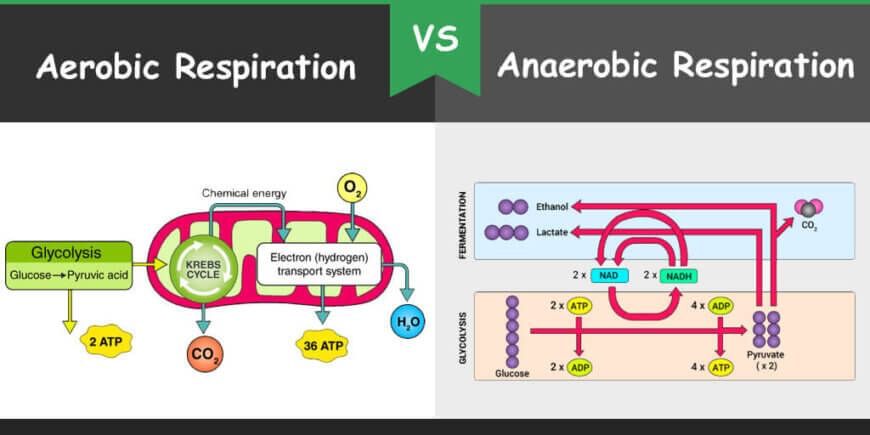 Aerobic and Anaerobic Respiration
Aerobic and Anaerobic Respiration
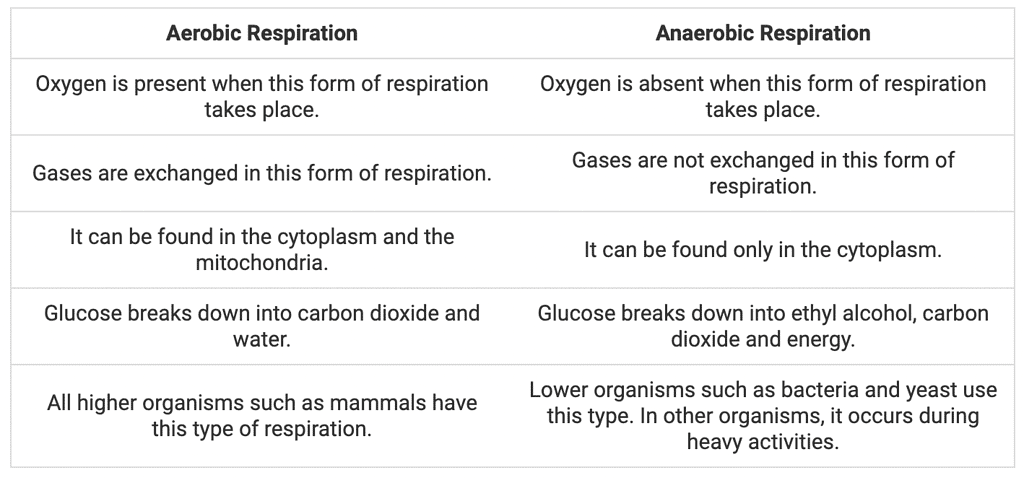 Difference between Aerobic and Anaerobic Respiration
Difference between Aerobic and Anaerobic Respiration
Human Respiratory System
- The human respiratory system consists of a group of organs and tissues that help us to breathe.
- Lungs are the primary organs of the respiratory system which help in the exchange of gases.
- The other main parts of this system include a series of airways for air passages, blood vessels and the muscles that facilitate breathing.
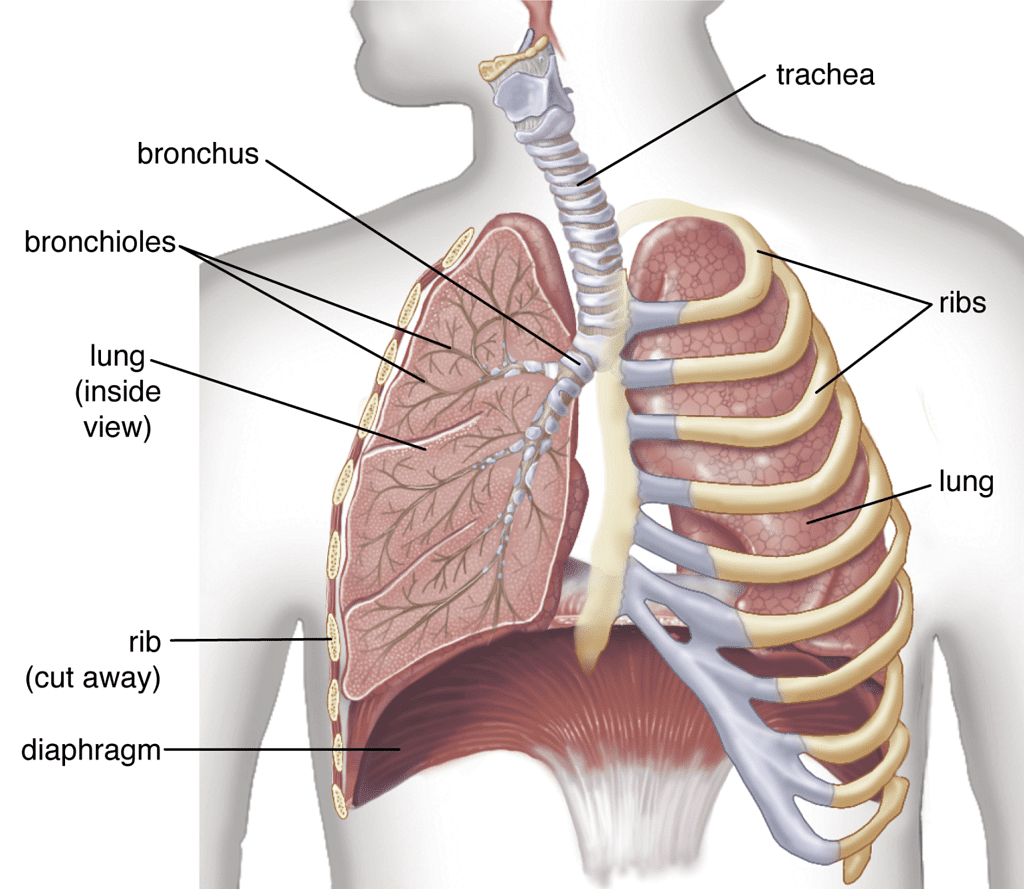
- The human respiratory system involves the nose, nasal cavities, pharynx, larynx, trachea/windpipe, bronchi, bronchioles and alveoli.
Respiratory Tract
External nostrils → Nasal cavity → Pharynx → Larynx → Trachea → Bronchi → Bronchioles → Alveolar sacs.
- The respiratory tract of the human respiratory system begins from a pair of external nostrils situated at the lower end of the nose.
- The air enters through the nostrils and reaches into a pair of nasal cavities.
- The two nasal cavities are separated from each other by a nasal septum. The nasal cavities are separated from the oral cavity by a bony palate. It is due to this reason we can breathe in air while we eat.
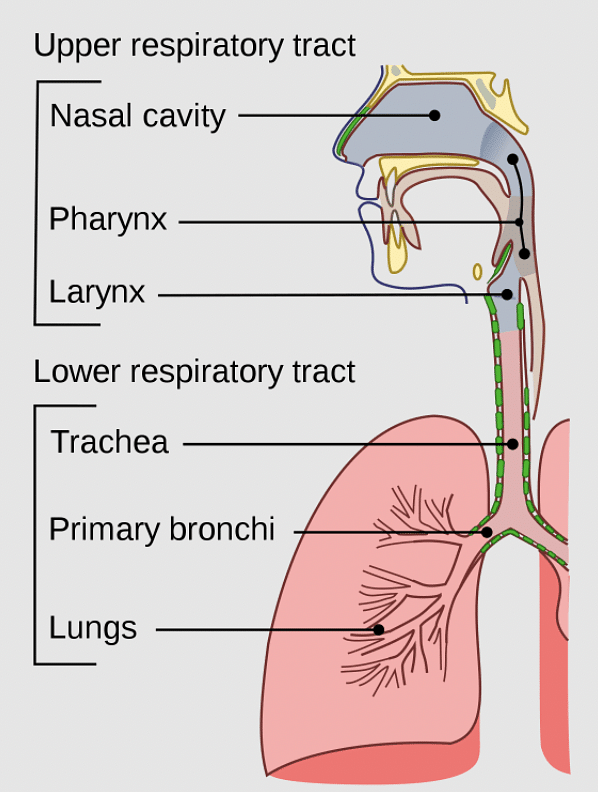
- The nasal passages are lined by ciliated epithelium and mucus-secreting cells so that the inspired air gets warmed, moistened and becomes dust-free. The dust particles are entrapped in the mucus secreted by mucus cells.
- The nasal cavity is also lined with olfactory epithelium which acts as an organ of smell.
- The nasal chambers open into the pharynx through internal nares.
- The pharynx is a short vertical tube located in the head at the back of the buccal cavity. It provides a passage into which the internal nares and buccal cavity both open to pass the air into it.
- The pharynx provides passage into the trachea or windpipe through a slit-like aperture, called the glottis. The glottis always remains open except during swallowing. The glottis bears a leaf-like cartilaginous flap, the epiglottis, at its anterior margin.
- During swallowing, the epiglottis closes the glottis to check the entry of food into it. Entry of food into the respiratory tract can be fatal.
- The trachea is about 11 cm in length and 2.5 cm in diameter. Its wall has incomplete (C-shaped) cartilaginous rings, which prevents the trachea from collapsing even if there is not much air in it.
- The trachea is lined internally by ciliated epithelium and mucus-secreting cells. The mucus and cilia both prevent the entry of dust particles and microbes. The trachea runs down the neck and extends into the thoracic cavity.
- On entering the thoracic cavity, the trachea divides into bronchi (singular: bronchus). On entering the lungs, the right bronchus enters into the right lung and the left bronchus enters into the left lung.
Voice Box
The voice box is also called the larynx. It is an enlarged upper part of the trachea. Before puberty, the larynx is inconspicuous and similar in both sexes.
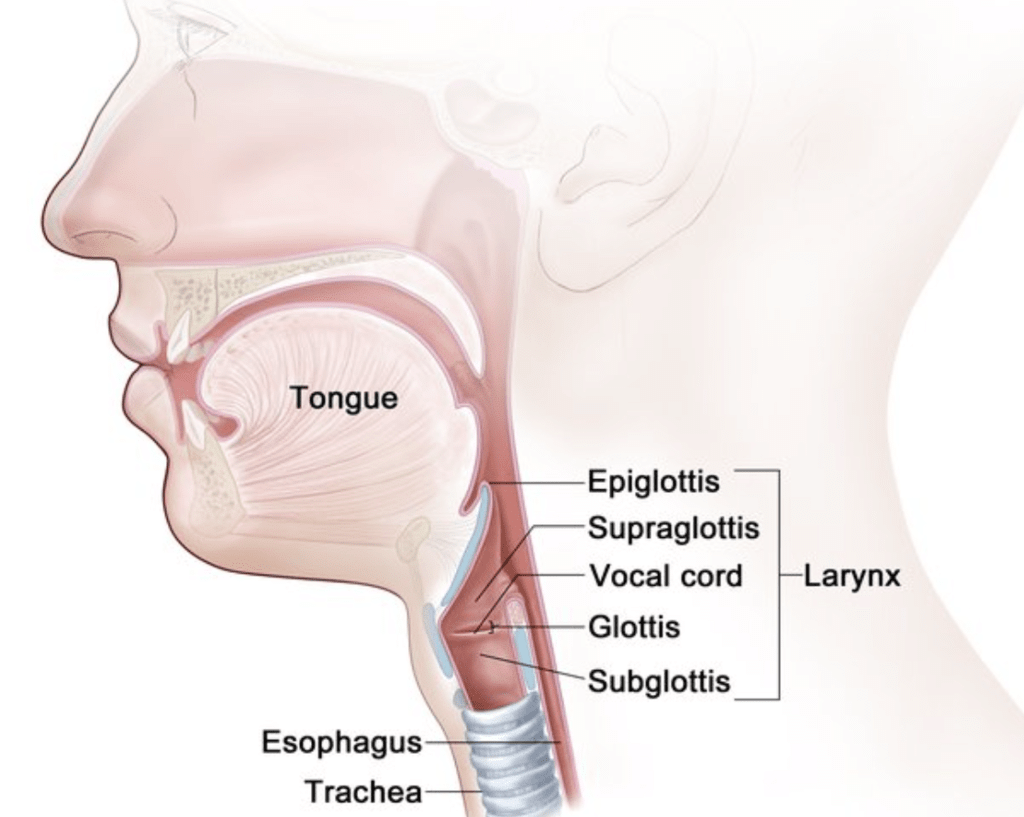
- In males, it often becomes prominent and protrudes out and often called "Adam's apple".
- Inside the larynx are the two vocal cords. These are folds of mucous membrane that extend into the lumen from the sides.
- Vibration in the vocal cords results in the production of sound which is altered and converted into speech with the help of the buccal cavity, soft palate, tongue and lips.
Lungs
The lungs are a pair of spongy, highly elastic, solid and bag-like organs. They are roughly cone-shaped and situated in the thoracic cavity.
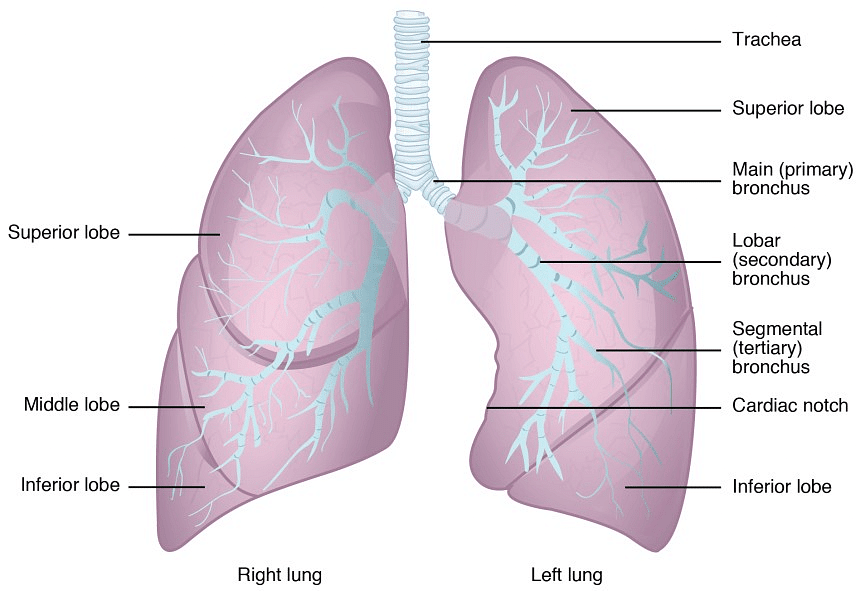
- The lungs are enclosed by a double-layered membrane or covering called pleura.
- The pleural membranes are separated by a thin space filled with pleural fluid which lubricates the membrane to avoid friction.
- Within the lung, each bronchus divides and redivides to form finer branches called bronchioles.
- Each bronchus with all its branches is called a bronchial tree. After repeated divisions, each bronchiole ends into a cluster of tiny air chambers called air sacs or alveoli.
- Alveoli are functional units of the lungs as these are the actual sites of respiratory exchange.
- There are about 750 million alveoli present in the lungs which have a total surface area of about 80 m2. Alveoli are covered with a network of capillaries.
Mechanism of Breathing
Lungs cannot expand or contract on their own. The contraction and expansion of the lungs are brought about by diaphragm muscles and external intercostal muscles.1. Inhalation (Inspiration)
Inhalation is the intake of fresh air from outside into the alveoli of the lungs. It occurs by the expansion of the lungs which is brought about by enlargement of the thoracic cavity.
Inhalation involves the following steps:
- The diaphragm (a sheet of tissue that separates the thoracic cavity from the abdominal chamber) muscle contracts so that the diaphragm lowers down and becomes flat.
- Lowering of the diaphragm pushes the abdominal viscera downward resulting in the enlargement of the thoracic cavity vertically.
- External intercostal muscles contract so that the ribs and sternum are pulled upward and outward. This causes enlargement of the thoracic cavity.
- Enlargement of the thoracic cavity results in the expansion of lungs.
- Expansion of lungs reduces the pressure of the air inside so that the fresh air is pulled from outside into the lungs passing through nostrils, trachea and bronchi.
- Fresh air has a rich supply of O2 which goes into the blood passing through thin membranes of alveoli and blood capillaries. As a result, the blood in the capillaries becomes loaded with oxygen and expels carbon dioxide into the alveoli for exhalation.
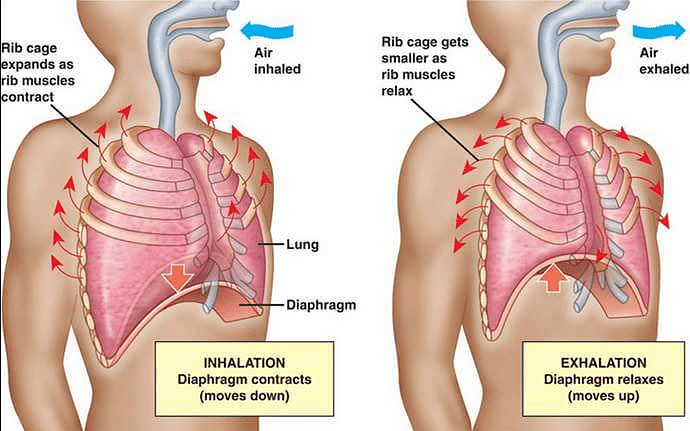 Breathing Mechanism
Breathing Mechanism
2. Exchange of Gases
Breathing is the first step of respiration which involves the exchange of gases between the air in alveoli and the blood capillaries (around the alveoli). - In this exchange, the blood takes up oxygen from the alveolar air and releases CO2 to the alveolar air.
- This exchange of gases is called external respiration and results in the oxygenation of blood. The heart supplies the oxygenated blood to the body tissues.
- The living cells perform the oxidation of simple food (glucose) to release energy. This is the process of aerobic respiration, which utilises O2 and releases CO2.
- The aerobic respiration occurs partly in the cytosol and partly in the mitochondria of cells. This catabolic process is called cellular respiration.
- The concentration of O2 is more in the blood and less in the tissue cells. So, the O2 moves from blood to the tissues by the physical process of diffusion.
- Similarly, CO2 concentration is more in tissues and less in the blood. So, the CO2 moves from tissues to the blood. The oxygenated blood now becomes deoxygenated.
3. Exhalation (Expiration)
The mechanism of breathing out of carbon dioxide is called exhalation.
- During exhalation, the phrenic muscle of the diaphragm relaxes so that the abdominal viscera pushes the diaphragm upward, making it convex.
- The external intercostal muscles also relax, resulting in reduced size of the thoracic cavity and lungs also contract.
- Contraction of lungs raises the air pressure so that the foul air moves out. The average rate of breathing in a normal adult man is 15 to 18 times per minute.
Differences between Inspiration and Expiration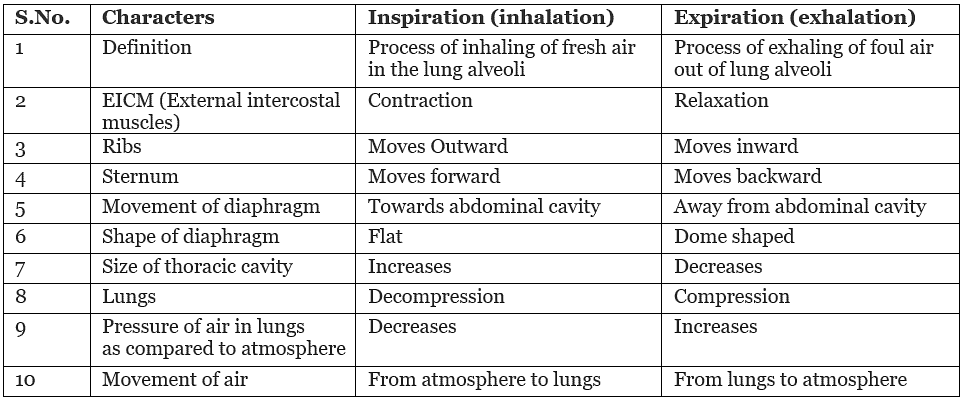
Location, structure and function of the Respiratory System

Respiration in Plants
- The plants do not have any special respiratory system so they have to respire in all of their individual parts like leaf, stem and root.
- The plants also have to exchange gases with the atmosphere by a simple diffusion process. Mode of gaseous exchange (oxygen and carbon dioxide) in plants.
In terrestrial plants, gaseous exchange occurs through:
- Stomata: In leaves and green stem.
- Lenticels: In woody stem and roots.
- Root hairs: In young roots.
1. Respiration through Stomata
Stomata are small apertures found on the surface of the leaf. For the process of respiration, oxygen enters stomata by the process of diffusion and then into other cells of the leaf. When the concentration of CO2 increases inside the cells it is diffused out through stomata.
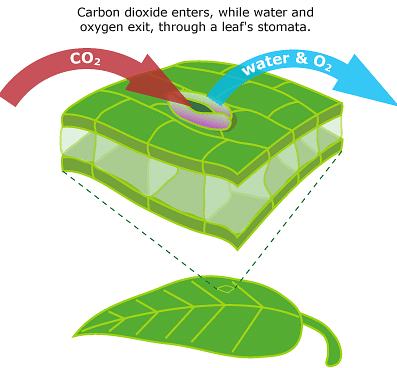 Respiration through Stomata
Respiration through Stomata
2. Respiration through Lenticels
Lenticels are the opening in the bark of woody stems. They also serve as a place of gaseous exchange.
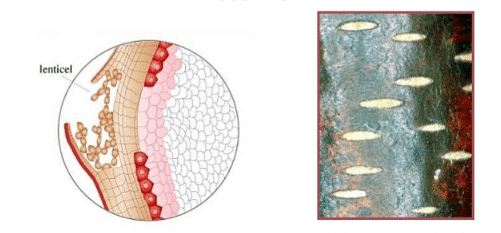 Respiration through Lenticels
Respiration through Lenticels
3. Respiration through the General Surface of the Roots
Ploughing or tilling of the soil creates small air spaces around soil particles which provides the sources of oxygen for the roots.
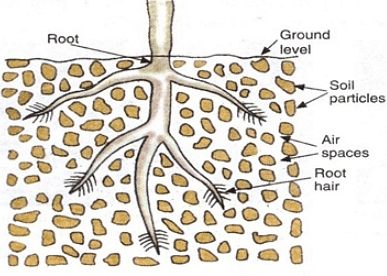 Respiration through Roots
Respiration through Roots
Respiration through Roots
- This oxygen present between the soil particles diffuses into root hairs (these are the extensions of an epidermal cell of the root), by the process of diffusion.
- From the root hairs, oxygen diffuses into other cells of the root. After the utilisation of oxygen, CO2 is diffused out into the soil.
- In older roots, there are no root hairs present. Instead, they have a layer of dead cells which is protective in nature and encloses small opening (lenticels). These are used for gaseous exchange between the soil and inner living cells.
- Aquatic plants can carry out gaseous exchange by diffusion over their whole surfaces.
- The direction of diffusion depends upon the environmental condition and the requirement of the plant.
- During the daytime, O2 release is a major event.
- During the night, CO2 release is the major event because there is no photosynthesis.
What is the difference between Photosynthesis & Respiration?
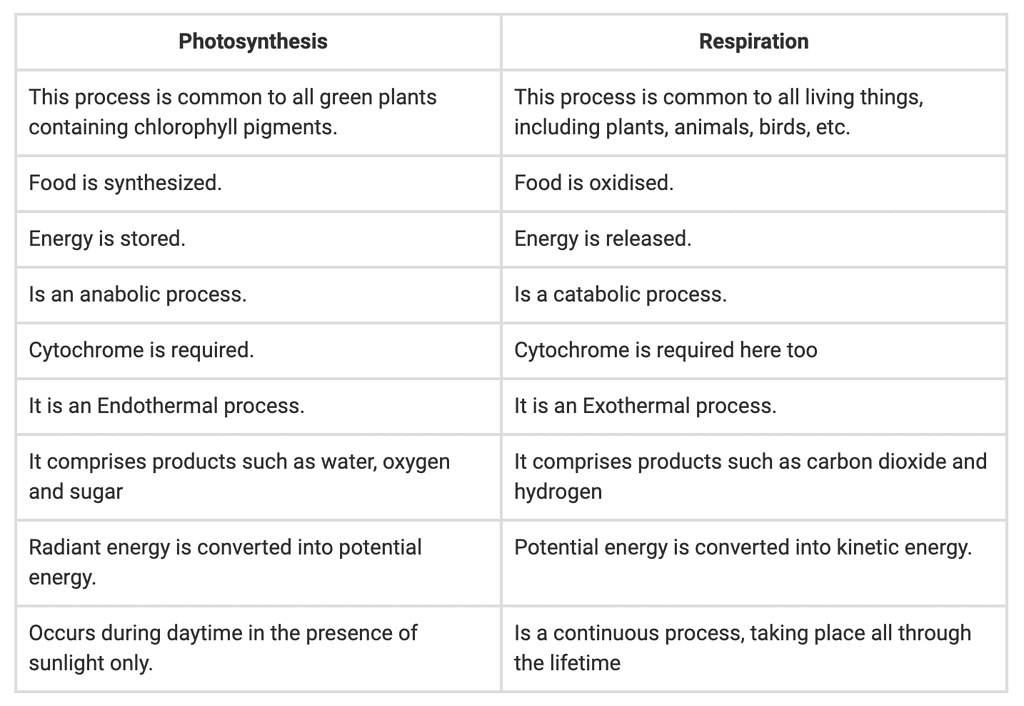
|
85 videos|437 docs|75 tests
|
FAQs on Respiration in Humans & Plants - Science Class 10
| 1. What is the respiratory system? |  |
| 2. What are the types of respiration? |  |
| 3. What is the mechanism of breathing? |  |
| 4. How does respiration differ in plants and humans? |  |
| 5. What is the human respiratory system? |  |

|
Explore Courses for Class 10 exam
|

|


















